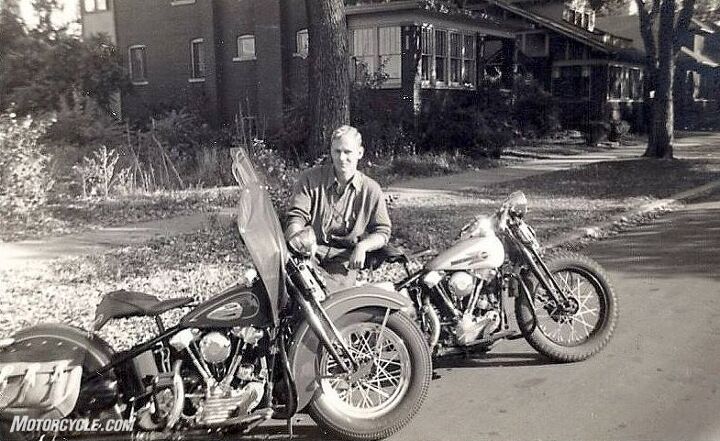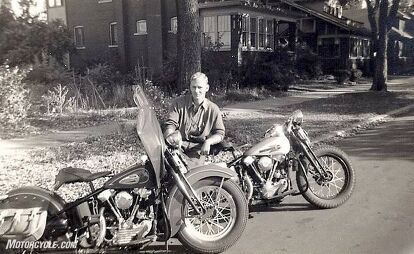Countersteer: The Story of Ryland S Wakeley

Stories are worth sharing
Ryland Wakeley Sr. was born in Chicago’s Beverly Hills neighborhood, a slightly less bougie part of town compared to the California city of the same name, in 1915. As a young child growing up in Chicago, one day Ryland found himself cruising on the back of a neighbor’s Harley-Davidson, watching the pavement fly by beneath him. It was at that moment the fire was lit. A lifelong passion for motorcycles, specifically Harley-Davidson, would ensue. From then on, whatever he had going on in his life, he made sure he had a motorcycle.
It was June 15, 1934, when 18-year-old Ryland Wakeley bought his first motorcycle, a 1928 Harley-Davidson JD, for fifty whole dollars. Working at a local drugstore at the time, he’d make deliveries for the shop on his motorcycle. Everyone in the neighborhood knew who he was, even if they didn’t know him by name, they knew him by the motorcycle.
As a child, Ryland and his family had vacationed in Muskegon, Michigan at a farmhouse the family owns and still uses to this day. Of course, as a motorcycle enthusiast, Ryland made his way to the local flat track to watch the races while they were visiting. Five years after buying his first bike, he picked up a high-compression (8.5:1) Harley-Davidson EL to begin racing. While his mother didn’t approve of his racing, he eased her nerves by telling her he only participated in the “slow races.”
In 1939, Ryland took off on what would be one of many long rides on his many Harleys. He and a high school friend headed west two-up on a 1938 Harley-Davidson EL, a single-seater which Ryland threw a bedroll and pillow on the back fender of for his friend to sit on. More than 2,000 miles later, they cruised into Santa Monica, California, rode right up onto the beach and stayed the night there. Exact details of the two’s time while in California are blurry, but it was definitely a trip they would never forget. Ryland’s friend had skipped the beginning of his senior year of high school to go on the trip, and they remained lifelong friends afterward with his friend sending him a Christmas card every year until his passing.
As they always seemed to, motorcycles would also play a part when Ryland met his wife, Laverne. One day, while working at a gas station at 95th and Damen in Chicago, Ryland heard a motorcycle rumble up to the station and went outside to check it out. There weren’t many motorcycles on the road around back then, let alone two-wheelers with bombshells like Laverne riding them. “Fill ‘er up,” she told him, and naturally, the rest is history. What Ryland didn’t know at the time was that Laverne had borrowed the motorcycle from a friend and ridden it to the gas station to impress him. In 1941, the two newlyweds spent their honeymoon riding around the perimeter of the United States.
The Wakeley’s would have five children. First, three girls, with two boys rounding out the quintet. Ryland Wakeley Jr. was the name given to the first boy. Ryland Sr. was ecstatic to have a boy to share his interests and hobbies with at a time when women were thought to have less interest in those sorts of things. Sr. took Ryland Jr. to his first flat track race at four-years-old, gave him his first leather jacket at five, and by the age of twelve, Jr. was practicing riding Sr.’s full-dresser around the yard – in case he dropped it since it was less likely to be damaged in the grass.
After Ryland Jr. had mastered the art of riding a big bike in the grass, he’d occasionally sneak his father’s bikes out of the garage, only to be busted later by Sr.’s meticulous mileage tracking. Jr.’s first bike would be a Harley-Davidson Rapido 125, an Aermacchi-era two-stroke Harley with scrambler styling, which he rode into the ground by the time he was 17-years old. He then picked up a 1975 AMF Harley-Davidson Sportster.
As he got older, Ryland Jr.’s enthusiasm for motorcycles didn’t carry the same weight in which it had for his father. At one point, Jr. had to decide whether to invest money into the business he wanted to start or spend it on two-wheeled ventures. Video equipment ultimately won out, but Jr’s enthusiasm for motorcycles never waned.
It was clear as we sat across from each other at a Dunkin Donuts in Chicago’s Beverly neighborhood, just blocks from where he and his father had grown up, that he had never forgotten his own passion for Harleys. There was a twinkle in his eye as he recounted his and his father’s history of motorcycling. I listened to Ryland Jr. tell me his father’s stories, sharing with me Sr.’s journals of the states he had visited on two wheels, prices he paid for bikes, and miles logged, as well as pictures from his mother and father’s lives. I imagined an extraordinary picture in my mind of Ryland S Wakeley’s life, albeit only composed of the snapshots we had discussed, and was thankful Ryland Jr had taken the time to share it with me.
In 1991, Ryland Jr. had a daughter named Geena, and although his riding had all but stalled at this point in his life, he maintained storage of his 1986 H-D Sportster. Geena would consider themselves a Harley family. Even though her dad wasn’t riding every day, it was always on his mind and deeply ingrained in their family history thanks to Ryland Sr. Her dad would tell her stories about her grandfather and whenever a Harley rolled up next to them at a stoplight, would tell her which model it was. As Geena grew up, she found an old shirt her dad had purchased at a flea market when he was in high school that read “It ain’t shit if it ain’t a Harley” and began wearing it as her own. More recently, she found an old jean jacket of her father’s with a large Sportster patch on the back that she’s been wearing, too.
“I never rode motorcycles or had an interest in riding,” said Geena, “but I developed a love for Harley’s because it symbolized so much family history and pride. My grandpa passed away when I was three-years-old, so I didn’t get to spend much time with him, but Harley’s have always reminded me of him and the memories I have. I love hearing my dad talk about his own motorcycles stories, too. I come from a family of pretty cool people with my dad and grandpa being two of the coolest and most adventurous. I wish I was as cool as them sometimes!”
The week prior to Ryland and my meeting, the prevalence of the passion and pride that exist towards the Harley brand, one of which is rivaled by no other motorcycle brand, had been impressed upon me. It’s one that transcends the actual riding or ownership of a motorcycle. While in Milwaukee, every other car I saw had a Harley sticker, whether it was a family sedan or a truck. After hearing Ryland Jr describe the family history and having Geena convey the family pride, it is even more apparent that the Motor Co. has played a huge role in so many lives and families throughout the years. Geena is a friend of my family who my wife met while working at TOMS shoes together. Their relationship led to me enjoying a cup of coffee in Chicago with Ryland Wakeley Jr. as he narrated his family’s motorcycling history. Some of the best stories can come from the most unlikely places. All it takes is the time to listen

Ryan’s time in the motorcycle industry has revolved around sales and marketing prior to landing a gig at Motorcycle.com. An avid motorcyclist, interested in all shapes, sizes, and colors of motorized two-wheeled vehicles, Ryan brings a young, passionate enthusiasm to the digital pages of MO.
More by Ryan Adams












































Comments
Join the conversation
I especially liked the 'fill her up' joke. A Harley or Indian was a cheap, reliable used bike in the 1930s to 1960s- not anymore. It is more about the Hardley Ableson Murican Made (with hidden foreign parts) overpaying now. The Indian Scout 60 seems good for the price, until you compare it to a Yamaha MT-07 or more comfortable for long trips Tracer 900.
I like the ergonomics afforded when the bikes had real saddles,
as opposed to the ridiculous clam shell ergos brought on by the "low rider" seats of today.